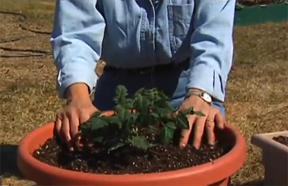Bulletin #2762, Container Gardening Series: Growing Vegetables in Container Gardens
 Adapted for Maine by Associate Extension Professors Kathryn Hopkins, Donna Coffin, and Frank Wertheim, and Extension Agriculture Coordinator Casey Bowie.
Adapted for Maine by Associate Extension Professors Kathryn Hopkins, Donna Coffin, and Frank Wertheim, and Extension Agriculture Coordinator Casey Bowie.
For information about UMaine Extension programs and resources, visit extension.umaine.edu.
Find more of our publications and books at extension.umaine.edu/publications/.
Are you short on space? Many kinds of vegetables can be easily grown in containers. Just follow these basic guidelines:
- Select containers. You can use buckets, empty milk jugs, dishpans, or window boxes. Each container should be clean and have at least one drainage hole in the bottom. Use a potting mix or mix your own with garden soil, compost, peat, and vermiculite.
- If you are starting plants from seed, check seed packets for planting and space recommendations. Not all of the seeds will germinate, so plant more seed than you need and thin later.
- If you are using transplants, fill each container until it is about half to three-quarters full. Then set your plants on the mix. Keep all plants at least one inch away from the side edge of the container so they don’t get too hot. Add potting mix around plants to within an inch of the top of the container and press lightly. Put your container where it will get at least 6 hours of sun each day.
- Water thoroughly. Plants in containers dry out more quickly than plants that are in the ground: you may have to water them daily.
- To keep plants growing and flowering, water with a balanced (20-20-20), water-soluble fertilizer, mixed as directed, every other week in summer. Pull any weeds out of your container.
- Pick your vegetables when they are ripe so the plant will continue to set more fruit. Then wash them and make something good to eat!
What to Grow
| Vegetable | Type of | Recommended Varieties |
|---|---|---|
| Beans, string | 5-gallon window box | Provider, Jade, E-Z Pick |
| Beets | 5-gallon window box | Early Wonder Tall Top, Red Ace |
| Broccoli | 5-gallon pot (1 plant); 15-gallon tub (3 plants) | Arcadia, Packman |
| Brussels sprouts | 5-gallon pot (1 plant); 15-gallon tub (2 plants) | Jade Cross, Oliver |
| Cabbage | 5-gallon pot (1 plant); 15-gallon tub (3 plants) | Gonzales, Arrowhead |
| Chard | 5-gallon window box | Bright Lights, Ruby Red |
| Chinese cabbage | 5-gallon pot (1 plant); 15-gallon tub (3 plants) | Minuet |
| Carrots | 5-gallon window box at least 12 inches deep | Thumbelina, Minicor, Parmex |
| Cucumber | 2-gallon bucket (1 plant) | Bush Champion, Littleleaf |
| Eggplant | 5-gallon bucket (1 plant) | Fairy Tale No. 226 |
| Lettuce | 5-gallon window box | Tom Thumb, Red Sails, Salad Bowl, Baby Oakleaf, any mini head variety |
| Onions | 5-gallon window box | Purplette, Gold Coin, Pearl Drop |
| Peas | 5-gallon window bucket | Caselode, Sugar Ann, Nova (leafless) |
| Sweet pepper | 2-gallon pot (1 plant); 15-gallon tub (5 plants) | King of the North, Ace |
| Radishes | 5-gallon window box | Easter Egg, most other types |
| Spinach | 5-gallon window box | Tyee, Space |
| Squash, winter | 5-gallon bucket | Burpee’s Butterbush, Bush Buttercup |
| Tomatoes | 5-gallon bucket | Patio, Roma, Sprite, Husky Red, Husky Gold, Husky Pink |
| Zucchini | 5-gallon bucket or pot | Eight Ball, Raven, Geode |
In addition, herbs such as parsley, chives, basil, and thyme are easy to grow in 5-gallon window boxes. Or, if you have a sunny window, grow them in smaller pots that you can move indoors for the winter.
Adapted with permission from Larry Bass, Container Vegetable Gardening, North Carolina Cooperative Extension Service, 1999.
Information in this publication is provided purely for educational purposes. No responsibility is assumed for any problems associated with the use of products or services mentioned. No endorsement of products or companies is intended, nor is criticism of unnamed products or companies implied.
© 2008
Call 800.287.0274 (in Maine), or 207.581.3188, for information on publications and program offerings from University of Maine Cooperative Extension, or visit extension.umaine.edu.
The University of Maine is an EEO/AA employer, and does not discriminate on the grounds of race, color, religion, sex, sexual orientation, transgender status, gender expression, national origin, citizenship status, age, disability, genetic information or veteran’s status in employment, education, and all other programs and activities. The following person has been designated to handle inquiries regarding non-discrimination policies: Sarah E. Harebo, Director of Equal Opportunity, 101 North Stevens Hall, University of Maine, Orono, ME 04469-5754, 207.581.1226, TTY 711 (Maine Relay System).

